Ijtikri
Ijtikris are a species of squid-like beings who are native to the island-strewn planet Vesk-2. They are characterized by their oblong body, which they hold roughly vertically atop muscular arms that surround their mouth. They have two long and dexterous feeding tentacles, which are tipped with pads that allow them to use tools. Ijtikris have an exoskeleton that covers their head and lower mantle, with a lighter exoskeletal lattice protecting their upper mantle. This facial plating gives rise to the Veskarium nickname for the species: stone-faced squids.
Ijtikris hatch from free-floating eggs in water and emerge as larvae that feed on zooplankton. Once large enough, the larvae migrate into coastal waters and anchor to hollows in rocks or reefs, where they filter feed and grow. By the latter part of their second year of life, they undergo metamorphosis into their adult form, including air-breathing lungs, before rising to the surface and swimming for land.
Each ijtikri has a cluster of ganglia known as a skenoseen organ, which helps them smell and locate the nearest group of mature ijtikris. These groups incorporate any newcomer, whose adoptive cousins teach them language, culture, and the skills necessary to survive.
Ijtikris mate numerous times over the course of their life and can begin a final metamorphosis at any point. During this transformation, their body fills with gas, splits their shell, and grows up to 20 feet in length. The body achieves aerial buoyancy and rises into the air, gently propelling itself toward the open sea. Once far from land, the ijtikri fertilizes stored eggs and disperses them before dying and descending into the water.
Ijtikris started as nomadic hunter-gatherers before adopting stone tools, which allowed them to implement agriculture, build villages, and fend off predators. When vesk starships landed on Vesk-2, the planet became part of the Veskarium. Ijtikris who have just emerged from the sea readily adopt almost any accepting group as surrogate families, making them natural recruits for Veskarium organizations. However, they have largely adopted vesk culture and contribute to local industries such as fish farming, salt production, and defrex ranching.
Ijtikris clashed with the vesk most strongly over ancient ruins that predate ijtikri stone-age culture. The vesk explored these ruins despite ijtikri pleading, leading to the discovery of the Trafodi Paradox, an artifact that was lost in transit to Vesk Prime.




Comments